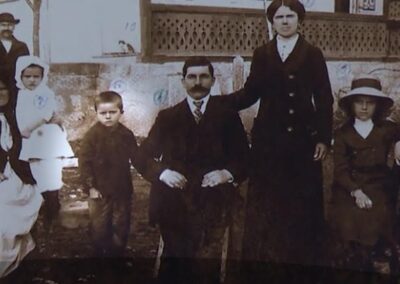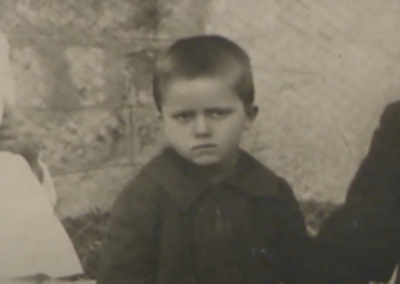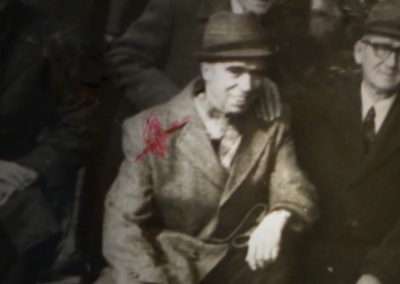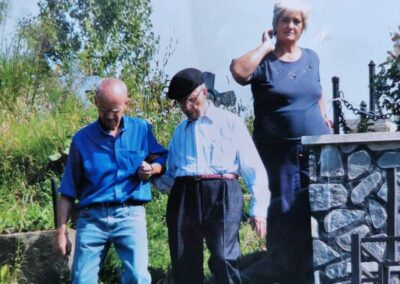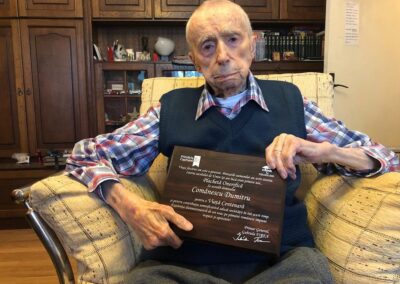BIOGRAPHY
Dumitru Comănescu was born in the village of Drăgăneasa (now Provița de Jos), Prahova County, Romania, on 21 November 1908 (8 November, according to the Julian calendar, which was in use in Romania at the time). He was one of six siblings. His parents, Ion and Susana, were 37 and 35 years old, respectively, when he was born. He mentioned that he enjoyed school and was the top of his class, often helping the teacher. His parents were busy with work, managing many animals, growing vegetables, and tending to beehives. They also had other workers who came to help, and his father had to oversee them. His mother took care of the household, and when he was little, he would help her make polenta. He said that his parents taught him and his siblings the value of hard work as a means to succeed. He didn’t remember much from World War I, as he was only six years old when it began. However, he recalled the Great Union of 1918.
During his school years, he was mentored by some remarkable individuals. He attended college, along with some of his brothers. In high school, he developed a strong passion for mathematics, excelling in the subject. This led him to enroll in the Faculty of Mathematics, where he studied under Gheorghe Ţiţeica. He lived in a dormitory in Bucharest, consistently earning a merit scholarship and maintaining high grades. Life was tough, and everything in the city was expensive, so his parents helped by sending food, though he managed the rest on his own. After a year, he switched to Agronomy, explaining that he had grown up in the countryside and had always been fascinated by the world of plants. There, he was guided by Gheorghe Ionescu Siseşti, the founder of the Institute of Agronomic Research. He graduated from university in 1933 and worked for 70 years. At the age of 86, he placed 5th in the country in an equivalency exam for agricultural experts. In 2003, he conducted his final phytopathological expert assessment.
After completing his studies, he moved to Târgovişte, where he met his wife, a pediatrician and the first cousin of the physicist Horia Hulubei. Together, they had two children, a daughter and a son. During World War II, as an agronomist engineer, he was mobilized to work behind the front lines, contributing to the country’s food supply. Despite this, he experienced many violent events and witnessed significant human loss. Following his wife’s death in 1990, he moved to Bucharest to live with his daughter and son-in-law.
Comănescu attributed his long life to two key factors: love and balance, which he considered the “secrets” to longevity. Additionally, his passion for learning kept his mind sharp. He also mentioned that he believed God, through the strength and genes He had given him, played a role in his long life. However, he acknowledged that daily factors were also important. He lived a modest life, free from excess. His family provided him with tremendous support, and later, his nephew’s wife, a nutritionist, helped him maintain his vitality by creating a special diet tailored to his needs. At the age of 111, it was reported that he followed this diet. Eating modestly, his family ensured that his meals were hearty and based primarily on unsaturated fats. Always staying informed about current social and political events, he enjoyed reminiscing fondly with his family.
At the age of 108, he suffered an accident in the countryside and fractured his hip. No hospital would accept him for surgery due to his age, but the staff at Foisor Hospital in Bucharest agreed to treat him. While hospitalized, he became a local “attraction” — both doctors and patients came to visit him.
Dumitru Comănescu passed away in Bucharest, Romania, on 27 June 2020, at the age of 111 years, 219 days. Three days before his death, he was awarded the Patriarchal Cross, the highest ecclesiastical honor of the Romanian Orthodox Church.
Dumitru Comănescu passed away in Bucharest, Romania, on 27 June 2020, at the age of 111 years, 219 days. Three days before his death, he was awarded the Patriarchal Cross, the highest ecclesiastical honor of the Romanian Orthodox Church.
RECOGNITION
On 16 May 2017, following the passing of 108-year-old Sofia Vrabie of Bacău, he became the oldest (known) living person in Romania, at the age of 107 years, 176 days. He held the title for more than three years, until his own passing in June 2020, when he was succeeded by Vasile Stămăteanu.
In November 2018, he celebrated his 110th birthday, becoming the first documented and later fully validated supercentenarian in Romania. However, he was not the first supercentenarian born in Romania.
His great-granddaughter, Sofia Alexandrescu, eventually realized that he could be one of the oldest living men in the world. She was the one who contacted Guinness World Records, leading to his official recognition.
On 28 May 2020, following the passing of 112-year-old Bob Weighton (UK), he became the oldest living man in Europe, at the age of 111 years, 189 days. He held the title for nearly a month, until his own passing, when he was succeeded by Saturnino de la Fuente García. At the time, it was assumed Comănescu also succeeded Weighton as the world’s oldest living man, and he was recognized by Guinness World Records on 28 May 2020. However, it was later revealed that both Tomás Pinales Figuereo and Emilio Flores Márquez were older than he was.
ATTRIBUTION
* “Cine este Dumitru Comănescu, cel mai vârstnic cetăţean al Bucureștiului” – Digi24, 22 June 2019
* “Povestea românului Dumitru Comănescu, cel mai bătrân bărbat din lume: amintiri din copilărie dinaintea primului război mondial” – Life.ro, 10 March 2020
* “World’s oldest man, 111, says love is the secret to long life after title passed on to him with the death of British 112-year-old” – Daily Mail, 29 May 2020
* “Dumitru Comănescu, declarat cel mai vârstnic bărbat al Planetei, a murit, la 111 ani” – Stirile ProTV, 27 June 2020

